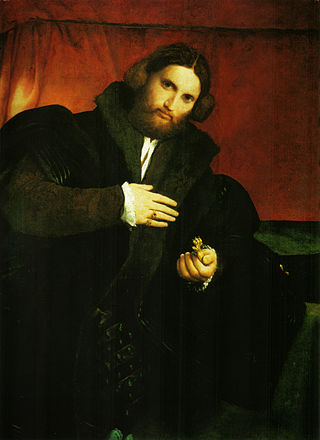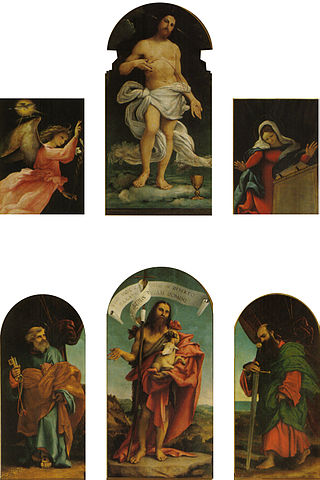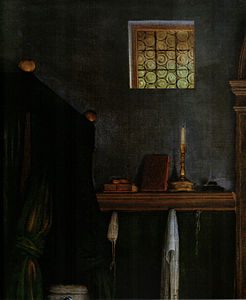
Lorenzo Lotto was an Italian painter, draughtsman, and illustrator, traditionally placed in the Venetian school, though much of his career was spent in other north Italian cities. He painted mainly altarpieces, religious subjects and portraits. He was active during the High Renaissance and the first half of the Mannerist period, but his work maintained a generally similar High Renaissance style throughout his career, although his nervous and eccentric posings and distortions represented a transitional stage to the Florentine and Roman Mannerists.

Alessandro Bonvicino, more commonly known as Moretto, or in Italian Il Moretto da Brescia, was an Italian Renaissance painter from Brescia, where he also mostly worked. His dated works span the period from 1524 to 1554, but he was already described as a master in 1516. He was mainly a painter of altarpieces that tend towards sedateness, mostly for churches in and around Brescia, but also in Bergamo, Milan, Verona, and Asola; many remain in the churches they were painted for. The majority of these are on canvas, but a considerable number, including some large pieces, are created on wood panels. There are only a few surviving drawings from the artist.

Altamura Cathedral, dedicated to the Assumption of the Blessed Virgin Mary, is a Roman Catholic cathedral in the city of Altamura, in the Metropolitan City of Bari, Apulia, in southern Italy.

The Annunciation is a painting by the Italian Renaissance master Titian, executed between 1559 and 1564. It remains in the church of San Salvador in Venice, for which it was commissioned.

The Assumption of the Virgin or Frari Assumption, popularly known as the Assunta, is a large altarpiece panel painting in oils by the Italian Renaissance artist Titian, painted in 1515–1518. It remains in the position it was designed for, on the high altar of the Basilica di Santa Maria Gloriosa dei Frari or Frari church in Venice. It is the largest altarpiece in the city, with the figures well over life-size, necessitated by the large church, with a considerable distance between the altar and the congregation. The images above and below are not Titian's work, they are by Palma Vecchio. It marked a new direction in Titian's style, that reflected his awareness of the developments in High Renaissance painting further south, in Florence and Rome, by artists including Raphael and Michelangelo. The agitated figures of the Apostles marked a break with the usual meditative stillness of saints in Venetian painting, in the tradition of Giovanni Bellini and others.

The Madonna and Child with Three Angels is a painting by the Italian Renaissance master Sandro Botticelli, executed around 1493. It is housed in the Pinacoteca Ambrosiana of Milan.

The Crucifixion is a life sized painting by the Venetian artist Titian, completed in 1558 and presently hanging in the sanctuary of the church of San Domenico, Ancona. Jesus Christ is shown crucified, with Saint Mary and Saint John standing either side of the cross in the Stabat Mater tradition. The kneeling figure is of Saint Dominic. The canvas was completed during Titian's fifth decade of painting, and is one of the works marking a shift toward his extensive exploration of tragedy and human suffering.

The Portrait of a Gentleman with a Lion Paw is an oil-on-canvas painting by the Italian High Renaissance painter Lorenzo Lotto, dating c. 1524–1525. It is housed in the Kunsthistorisches Museum, in Vienna.

Malchiostro Annunciation is a painting by the Italian Renaissance artist Titian, completed around 1520, and housed in the Cathedral of Treviso, northern Italy.

The Recanati Polyptych is an oil-on-panel painting by the Italian Renaissance painter Lorenzo Lotto, executed in 1506–1508 and housed in the Civic Museum of Villa Colloredo Mels, Recanati, Italy. The work is dated and signed Laurent[ius] Lotus MDVIII.

The Annunciation has been one of the most frequent subjects of Christian art. Depictions of the Annunciation go back to early Christianity, with the Priscilla catacomb in Rome including the oldest known fresco of the Annunciation, dating to the 4th century.
Il Paradiso is a massive oil painting on canvas that dominates the main hall of the Doge's Palace, which hosted the Great Council of Venice. It is one of the largest paintings on canvas in the world and was painted by Jacopo Robusti, known more commonly as Tintoretto. The painting features a heavenly scene with depictions of various religious figures such as the portrayal of Justina, patron saint of Padua.

Volterra Cathedral is a Roman Catholic cathedral in Volterra, Italy, dedicated to the Assumption of the Virgin Mary. It is the seat of the bishop of Volterra.

Religion saved by Spain is an oil on canvas painting produced between 1572 and 1575 by Titian, an Italian master of the Venetian school, commemorating the Battle of Lepanto in 1571. It is one of his later works, and is considered to be an outstanding piece. Other titles are Spain succoring Religion or Religion assisted by Spain.

Adoration of the Shepherds is a c.1534 oil-on-canvas painting by the Italian Renaissance artist Lorenzo Lotto, signed "Lottus" and now in the Pinacoteca Tosio Martinengo in Brescia. Its dating is based on stylistic motifs such as the naturalistic details similar to those of the Recanati Annunciation. It also shows similarities to nativities painted around the same time by Girolamo Savoldo, whom Lotto met in Venice. It seems to have been commissioned by Braccio II and Sforza Baglioni, two noblemen from Perugia, who were the models for the two shepherds. They may have met the artist in the Marche during a pilgrimage to Loreto. A ring on Mary's right hand is probably an allusion to the Holy Ring, a relic in Perugia Cathedral, which supports the idea that the work was produced for that city. This provenance is solely based on an account from 1824 by the art dealer who that year sold it to Paolo Tosio, a count from Brescia.

St Antoninus Giving Alms or The Alms of St Antoninus is an oil-on-canvas painting by the Italian artist Lorenzo Lotto, created c. 1540–1542. It depicts Archbishop Antoninus of Florence giving alms as an allegorical ideal for bureaucratic charity. The painting is now displayed in the Basilica dei Santi Giovanni e Paolo in Venice.

Christ Taking Leave of his Mother is an oil-on-canvas painting by the Italian Renaissance artist Lorenzo Lotto, dated to 1521 and now in the Gemäldegalerie, Berlin. It has several similarities with the small Christ Taking Leave of his Mother by Correggio now in London.

The Ponteranica Altarpiece is a six-panel oil painting series produced by Lorenzo Lotto in 1522, commissioned by the Scuola del Corpo di Cristo for the parish church of San Vincenzo e Sant'Alessandro in Ponteranica, where it still remains. Its upper register shows the risen Christ flanked by an Annunciation scene, whilst below is John the Baptist flanked by saints Peter and Paul.

The Assassination of Saint Peter Martyr or The Martyrdom of Saint Peter of Verona is a 1530–1535 oil on canvas painting by Moretto da Brescia, now in the Sala dell'Esedra in the Pinacoteca Ambrosiana in Milan.

The Annunciation is an oil-on-canvas painting by the Italian Baroque painter Giovanni Lanfranco. It is the main altarpiece of the first chapel on the right in the church of San Carlo ai Catinari in Rome, Italy.





















